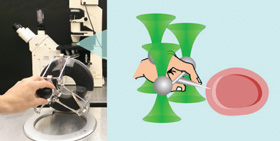New Haptic Microscope Technique Allows Researchers to "Feel" Microworld
From the Journal: Review of Scientific Instruments
WASHINGTON, D.C. Sept. 13, 2013 — What if you could reach through a microscope to touch and feel the microscopic structures under the lens? In a breakthrough that may usher in a new era in the exploration of the worlds that are a million times smaller than human beings, researchers at Université Pierre et Marie Curie in France have unveiled a new technique that allows microscope users to manipulate samples using a technology known as “haptic optical tweezers.”
Featured in the journal Review of Scientific Instruments, which is produced by AIP Publishing, the new technique allows users to explore the microworld by sensing and exerting piconewton-scale forces with trapped microspheres with the haptic optical tweezers, allowing improved dexterity of micromanipulation and micro-assembly.
“The initial results obtained are promising and demonstrate that optical tweezers have a significant potential for haptic exploration of the microworld,” said Cecile Pacoret, a co-author of the study. “Haptic optical tweezers will become an invaluable tool for force feedback micromanipulation of biological samples and nano- and microassembly parts.”
 One of the challenges in developing this technique was to sense and magnify piconewton-scale forces enough to enable human operators to perceive interactions that they have never experienced before, such as adhesion phenomena, extremely low inertia, and high frequency dynamics of extremely small objects, like the Brownian motion. The design of optical tweezers for high quality touch-based feedback is challenging, given the requirements for very high sensitivity and dynamic stability.
One of the challenges in developing this technique was to sense and magnify piconewton-scale forces enough to enable human operators to perceive interactions that they have never experienced before, such as adhesion phenomena, extremely low inertia, and high frequency dynamics of extremely small objects, like the Brownian motion. The design of optical tweezers for high quality touch-based feedback is challenging, given the requirements for very high sensitivity and dynamic stability.
This research required a mix of different experimental techniques and theoretical knowledge. Labs at the Institut des Systèmes Intelligents et de Robotique possessed expertise in both microrobotics and in haptics which were needed but the research team, as the project progressed, realized that they needed additional expertise in optics and vision, which was available at the university. “This project would not have been possible without this multidisciplinary environment and additional collaboration of the international optical tweezers community,” states Dr. Pacoret. “The high level of interdisciplinary cooperation is what made this project unique, and contributed to its success.”
The ability to use touch as a tool to allow exploration, diagnosis and assembly of widespread types of elements from sensors, microsystems to biomedical elements, including cells, bacteria, viruses, and proteins is a real advance for laboratories. These objects are fragile, and their dimensions make them difficult to see under microscope. If this tool can restore the sense of touch under microscopic operation, it will help not only efficiency but also expand scientific creativity, said Dr. Pacoret, adding that she and her team are excited about the possibilities.
“This tool will offer a new degree of freedom and accessibility to researchers, providing, for example, new versatility for the study and micromanipulation of cells,” she said.
###
For More Information:
Jason Socrates Bardi
jbardi@aip.org
240-535-4954
@jasonbardi
Article Title
A review of haptic optical tweezers for an interactive microworld exploration
Authors
Cécile Pacoret and Stéphane Régnier
Author Affiliations
Université Pierre et Marie Curie in France
